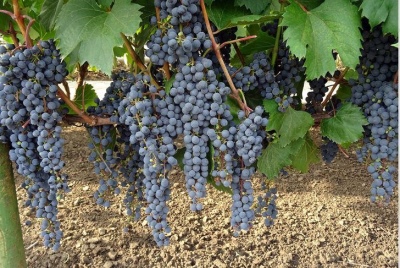
- Authors: University of Minnesota, USA
- Appointment: technical
- Berry color: dark blue, almost black
- Taste: harmonious
- With bones: Yes
- Ripening period: early middle
- Ripening period, days: 140
- Frost resistance, ° C: -34
- Name synonyms: Minnesota 1047 (Minnesota 1047, MN 1047), Frontenac
- Bunch weight, g: 100-130
The American breeding school has produced many attractive types of fruit plants. One of them is the Frontignac grape. Many gardeners will find it useful and interesting to get acquainted with such a technical variety.
Breeding history
Frontignac created a breeding group at the University of Minnesota. Riparia 89 and Lando noir were used to breed it. The plant was officially approved for cultivation in 1996. The license was issued in 2003. In our country, the variety is still not widespread enough.
Description
Frontignac has 4 synonyms - Minnesota 1047, Frontenac, Minnesota 1047, MN 1047. The plant is distinguished by decent fertility. It is suitable for making wine. Bushes are prone to strong development. The prospects for use are very high.
Ripening period
Frontignac is classified as an early medium grape. Under normal conditions, it ripens in 140 days. Under the influence of meteorological conditions, this period can change quite actively.
Bunches
The brush of this variety has a shape that transitions from a cylinder to a cone. The bunches are usually loose. Occasionally they reach medium density. The weight of the vine is on average from 0.1 to 0.13 kg.
Berries
The grapes are dark blue, sometimes almost black. They contain numerous bones. A waxy coating develops on the surface of the thickened dense peel. The weight of a grape is 1.2-1.4 g. Its size is always small.
Taste
Tasters note:
- harmony of taste sensations;
- the meatiness and juiciness of the fruit;
- sugar content - 0.26 kg per 1 cu. dm;
- a high level of acidity (not allowing the use of the crop for table purposes).
Yield
In terms of fertility, Frontignac stands out favorably among other varieties. The sources do not provide exact figures. However, there are mentions that the plant will have to be protected from overload.


Growing features
Even despite the heavy load of the vines, the grapes will ripen very well. Stepson's maturation is quite active. The variety is suitable for the hanging cordon system. Reproduction is mainly carried out by root cuttings. Survival even in harsh conditions is very high.
Landing
There are no specific recommendations for this particular variety. However, you can apply the same methods as for other hardy varieties. It is necessary to choose seedlings with clean, healthy roots. The leaves should also be free from defects.
You should prepare a well-lit area and dig trenches on it, the width and depth of which are the same (60 cm). It is best to choose trellises from a metal pipe.

Pollination
The flowers of the grapes are bisexual, therefore, it is practically not required to pollinate it on purpose. Only in extremely bad weather does the situation change.
Pruning
Frontignac is characterized by high growth activity. The vine is cut into 2-3 eyes. 1 bush will have 40 to 45 eyes. Normalization is required. When working, use only the sharpest pruning shears.



Frost resistance and the need for shelter
The safety of the bushes is guaranteed at temperatures up to -34 degrees. In most regions of Russia, it will not be necessary to harbor a culture. Special protection is not needed even in the northern regions (such as the Moscow region and other territories of central Russia).

Diseases and pests
In relation to gray rot, Frontignac has absolute immunity. It is also quite resistant to mildew. The situation is a little worse with oidium and with root phylloxera. Cracking is completely out of the question. There are no special pests for this particular variety.

If a grape is exposed to any disease or insect, this always affects its appearance.
Storage
Saving the fruits of Frontignac for a long time is not possible. They quickly frown and lose their commercial qualities. Most often, the harvest is processed into wine. It usually has a reddish garnet color.
It is recommended to make wine blends with other types of grapes that are less acidic. It is very important to control the contact time of the juice and berry shells in order to achieve a good color.











































































